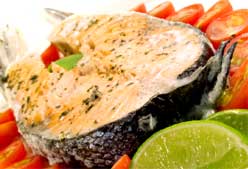Today the Monterey Bay Aquarium – with whom Environmental Defense Fund partners on its Seafood Selector – updated its popular Seafood Watch pocket guides. A number of new and revised rankings were part of the update, including the first-ever farmed salmon to reach the ‘Green’ (Best Choice) list.
Perhaps the most notable new ranking is for Alaska pollock, which was moved from ‘Green’ (Best Choice) to ‘Yellow’ (Good Alternative). If you’ve never heard of pollock, it’s related to cod and is actually the fourth most popular seafood item in America. It’s the whitefish used in fish sticks, fish filet sandwiches, and surimi (imitation crab meat). Pollock is the largest fishery in the United States (and the largest food-fish fishery in the world), with annual catches averaging two billion pounds.
Some people may interpret the ‘Good Alternative’ ranking to mean that the Alaska pollock is no longer sustainable. Rather, Monterey Bay Aquarium’s new report, which took more than a year to write, highlights some environmental challenges facing the fishery, but ultimately concludes that pollock is still a good choice for both seafood consumers and businesses. (This fact was confirmed yesterday when the pollock fishery was recommended for re-certification to the Marine Stewardship Council).
Here’s a brief outline of Monterey Bay Aquarium’s findings:
1. Pollock biology
The good news: Pollock mature quickly, are short-lived and reproduce often, making them resilient to fishing pressure. Important spawning areas are also off-limits to fishing.
2. Status of pollock stocks
The good news: pollock populations are not overfished, and are still considered healthy;
The bad news: they have steadily declined from all-time highs earlier this decade. The stock is also influenced by changing environmental conditions, and climate change is affecting the Bering Sea faster than many other places on Earth.
Outlook: Fishing quotas have been reduced in each of the last four years to account for less pollock, and the latest projections show the stock rebounding by 2012.
3. Bycatch
The good news: the pollock fishery is one of the ‘cleanest’ – averaging less than 1% bycatch relative to overall catch.
The bad news: bycatch of chinook salmon – a commercially and culturally important species in coastal Alaskan communities – steadily increased from 2001-2007, peaking at 120,000 fish.
Outlook: the pollock industry instituted a voluntary bycatch avoidance program in 2008 that helped reduce salmon bycatch by more than 80% in just two years. Additional regulations are scheduled to go into effect in 2011.
4. Habitat & ecosystem impacts
The good news: the latest government study concluded that groundfish fisheries (including pollock) have only minimal and temporary impacts on the Bering Sea floor.
The bad news: the study also showed that midwater pollock trawls contact the bottom more than originally thought (~44% of the time), which reduces sensitive habitat features in parts of the Bering Sea. There are also concerns about the effect of the fishery on Steller sea lions and northern fur seals.
Outlook: The North Pacific Fishery Management Council has closed sensitive areas to pollock fishing in an effort to protect bottom habitats and important marine mammal sites. Additionally, new science will continue to identify sensitive areas in need of protection.
5. Management
The good news: the pollock fishery is managed by one of the strongest catch share management systems in the world. It is well-equipped to tackle conservation challenges quickly and effectively, and features a number of characteristics shared by few others:
- The pollock fleet regularly catches less than their quota, meaning that in many years, they intentionally leave millions of pounds of fish in the water;
- The North Pacific Council has set the Total Allowable Catch at or below the levels recommended by its scientific advisory body every year since 1977;
- Most pollock vessels have 100% observer coverage – which is paid for by industry – minimizing the government’s cost to effectively manage this fishery;
- The cooperative nature of the pollock fleet means they can share information and respond to environmental issues – such as salmon bycatch – in real-time (as opposed to the slower nature of the Council process);
- The pollock management plan features a number of protections for the marine ecosystem at-large, including a provision to ensure that pollock populations are large enough to provide adequate food for marine mammals and other predators;
- The management system and the pollock industry cooperatively collect an unprecedented amount of scientific information about the fishery and the marine ecosystem. These data are used for stock assessments, monitoring quotas and bycatch, assessing habitat and ecosystem impacts, and improving the conservation and management of marine resources in Alaska.
The bottom line is that pollock remains a sustainable seafood choice for both consumers and businesses. The fishery has demonstrated unparalleled sustainability leadership in the past and is well-positioned to address new environmental issues. Their innovative catch share management system is more responsive than conventional approaches, meaning they can identify and address issues as they arise (as opposed to most fisheries, which often find out once it’s too late). Finally, all Monterey Bay Aquarium and Environmental Defense Fund seafood rankings are updated as new information emerges, meaning any changes in the pollock fishery will quickly be reflected in future assessments.










 Last week, as part of its 25th anniversary celebration, the Monterey Bay Aquarium’s Seafood Watch program released a report entitled, “
Last week, as part of its 25th anniversary celebration, the Monterey Bay Aquarium’s Seafood Watch program released a report entitled, “